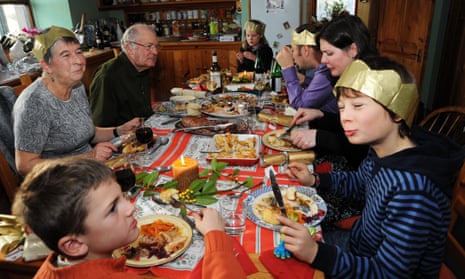The UK recorded 25,161 new Covid cases yesterday, 16,740 Covid patients were in hospitals, only 20% below the April peak, and there were 612 deaths. All this before restrictions are lifted so that three households are allowed to mix for up to five days. If this happens, the consensus of doctors and health professionals is that more people will be infected, more will die and the NHS may well be overwhelmed.
This much we are all too aware of, but as we make plans for a festive season spent in the company of our nearest and dearest, many will be pushing these thoughts aside. It’s difficult to perceive the home you grew up in, or time spent with the people closest to you, as “risky”. But what you might not be aware of is the “the intimacy paradox”, which can lead us to be most in danger with people and in places who are most familiar to us and with whom we feel the safest.
For many years, I have studied how intimacy is produced between people, especially in groups, and how it affects our feelings, thoughts and actions even at the most visceral level. In one study I conducted at the University of St Andrews, where I teach psychology, we asked students to smell soiled, sweaty T-shirts. These either had our logo or a Dundee University logo. When it was the former, they were only mildly perturbed – when they were done, they strolled over to clean their hands, used a modicum of soap and did only a perfunctory wash. But when it was the latter, they screwed their faces up in true disgust, they rushed over to get clean and used copious soap for a prolonged scrub. In short, disgust for the ingroup sweat was far less than that for the outgroup.
Linked to this loss of disgust for the ingroup is a desire for greater physical proximity for fellow ingroup members. In another study, we divided people into two groups on trivial grounds (whether they over- or underestimated the number of dots in a pattern). We then told them that they would be talking to someone who was either in the same group as them or the other group, and we asked them to arrange the chairs in a way that would make them feel most comfortable. In the ingroup condition they placed the chairs 20% closer than in the outgroup condition.
Now let’s move away from the experimental laboratory to the confluence of the Ganges and Yamuna rivers – a sacred site in northern India that is home to the Prayag Kumbh Mela, an annual month-long Hindu festival that every 12 years attracts more than 100 million people. It has been described without hyperbole as “the greatest show on Earth”. The event is intensely crowded, incessantly noisy and indescribably unhygienic. And yet, when you ask the attending pilgrims (kalpwasis) to describe it, they use terms such as “serene” and “blissful”. What is more, despite the fact that all these factors should be detrimental to health, and despite concerns about the Mela as a site for the spread of infectious diseases, our work shows that, overall, attendance is good for one’s physical health and mental health.
And the reason, as with the studies on sweaty T-shirts and chairs, comes back to the sense of shared identity in a group, the fact that people do not see fellow kalpwasis as “other” but as part of an extended social self. Correspondingly they see them as an asset rather than an impediment, as being there to support rather than block them. This increases their sense of mastery, of coping. It lowers stress. It increases wellbeing.
So far, then, we see how the creation of intimacy has powerful effects on body as well as mind. But these are highly positive. So where is the danger? And where is the paradox? Well, it’s because there is a downside to seeing others in such positive terms as an asset and as a support. It is illustrated in work on pilgrims at another huge event: the Hajj, or pilgrimage to Mecca. Those pilgrims who identify highly with others feel safest when most packed in with others – but this can increase the crowd density, which has led to appalling tragedies such as the 2015 disaster in which 2,400 people were crushed to death. That desire for physical proximity to those we are psychologically close to, which we found in the lab, can literally be deadly in the field.
Our work on the Mela and other mass gatherings points to further dangers. The intimacy and lower boundaries among attendees can lead people to neglect their health, to overstrain themselves and to share food and drink, make-up and even toothbrushes. Viewing our intimates as sources of support and safety leads us to take risks that place us in danger – especially in the presence of a virus.
And so our tour lands us back in the bitter reality of this Covid Christmas. What could be more familiar than meeting one’s family in one’s home? Family are the people one can relax with. The very definition of home is a place where one can forget the conventions and restrictions of the public sphere and lower our guard against the disapproving gaze of strangers. And as we forget these restrictions and conventions – as we get closer and sup from the same pot – so, the conditions for the spread of infection become ever more perfect.
And that is why the cause for concern this Christmas is not only that we are mingling, but mingling at home. Because this intimate space and this space of intimates may be the best of worlds in ordinary times. But that very fact can make it the worst of worlds in a time of pandemic.
Stephen Reicher is a professor of psychology at the University of St Andrews and a member of the behavioural science advisory group to Sage

